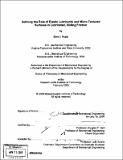| dc.contributor.advisor | Douglas P. Hart. | en_US |
| dc.contributor.author | Hupp, Sara J. (Sara Jean), 1979- | en_US |
| dc.contributor.other | Massachusetts Institute of Technology. Dept. of Mechanical Engineering. | en_US |
| dc.date.accessioned | 2008-11-07T19:07:49Z | |
| dc.date.available | 2008-11-07T19:07:49Z | |
| dc.date.copyright | 2008 | en_US |
| dc.date.issued | 2008 | en_US |
| dc.identifier.uri | http://hdl.handle.net/1721.1/43143 | |
| dc.description | Thesis (Ph. D.)--Massachusetts Institute of Technology, Dept. of Mechanical Engineering, 2008. | en_US |
| dc.description | Includes bibliographical references (p. 203-204). | en_US |
| dc.description.abstract | Solutions for reducing friction in sliding, lubricated systems include modifying lubricant rheology using polymers and adding a micro-scale texture to the sliding surfaces, but the mechanism of how lubrication properties and surface texturing interact is poorly understood. This thesis presents a study of lubricant elasticity and surface micro texturing and explains the mechanisms for the resulting altered frictional profile on the Stribeck diagram. In this work, isolating non-Newtonian effects in the lubrication flow is shown to normalize the frictional profiles of elastic and Newtonian lubricants. These non-Newtonian effects were determined to be the shear rate-dependent lubricant viscosity and the added normal stresses of the elastic lubricant undergoing shear flow. A modified Gumbel number is presented that includes the shear rate-dependent viscosity and scales the normal stress using the Deborah number. Experimental results from testing both elastic and inelastic lubricants using a triborheometer support the use of the new modified Gumbel number in place of the traditional Gumbel number for normalizing the effects of lubricant elasticity on the Stribeck diagram. To analyze the effect of surface micro texturing on the frictional profile, step-bearing theory and assumptions about the surface/lubricant interaction are used to develop scaling parameters for the transition velocities between lubrication regimes on the Stribeck diagram. These parameters indicate how the surface texture geometry can be altered to induce or delay transition between lubrication regimes. Micro textured surfaces are fabricated using photolithography and electroless nickel plating techniques, and friction testing indicates that the new scaling parameters successfully capture the trends of the related transition velocities. | en_US |
| dc.description.statementofresponsibility | by Sara J. Hupp. | en_US |
| dc.format.extent | 204 p. | en_US |
| dc.language.iso | eng | en_US |
| dc.publisher | Massachusetts Institute of Technology | en_US |
| dc.rights | M.I.T. theses are protected by
copyright. They may be viewed from this source for any purpose, but
reproduction or distribution in any format is prohibited without written
permission. See provided URL for inquiries about permission. | en_US |
| dc.rights.uri | http://dspace.mit.edu/handle/1721.1/7582 | en_US |
| dc.subject | Mechanical Engineering. | en_US |
| dc.title | Defining the role of elastic lubricants and micro textured surfaces in lubricated, sliding friction | en_US |
| dc.type | Thesis | en_US |
| dc.description.degree | Ph.D. | en_US |
| dc.contributor.department | Massachusetts Institute of Technology. Department of Mechanical Engineering | |
| dc.identifier.oclc | 247951631 | en_US |
